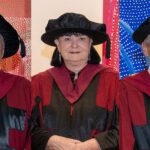Ancient stories about the stars will inspire an international touring exhibition of astronomically-themed artworks created by Indigenous Australian and South African artists from the two Square Kilometre Array (SKA) telescope sites in Africa and Australia.
The project, Shared Skies: Indigenous Australian and African art inspired by the sites of the SKA, is funded by several organisations around the world including the Australian SKA Office and Curtin University.
Curtin University and CSIRO Astronomers, and artists from Yamaji Art in Geraldton and Mullewa, recently gathered under a starry night sky at the Murchison Radio-astronomy Observatory (MRO) – 350 kilometres north-east of Geraldton – to share their perspectives on constellations and stars.
Professor Steven Tingay, Director of the Murchison Widefield Array and Professor of Radio Astronomy at Curtin University, said he was excited to be involved in a cultural exchange similar to that which took place in 2009, during the International Year of Astronomy.
“Our collaboration with Yamaji Art allows us to connect the ancient with the present, for astronomers and Indigenous people to share their understanding of what stars are, and what they represent to our cultures,” Professor Tingay said.
“Inspired by the sharing of cultures and stories about the stars, the artists will now create paintings that will combine with similar artwork from South Africa for an international art exhibition.”
“These stories are important to our connection to the past, the land and the future”, said Wajarri Elder and artist, Kevin Merritt.
The exhibition will be launched at Curtin University’s John Curtin Gallery in September, coinciding with an international SKA conference in Perth, and will tour SKA-member countries around the world.
Australian Square Kilometre Array Director, Professor Brian Boyle also attended the gathering of artists and scientists and is excited for the launch of the exhibition.
“A similar sharing of cultures will take place in South Africa and I’m looking forward to seeing the artworks produced at both sites,” Professor Boyle said.
“These are two very different locations, half a world apart, connected by a shared night sky. Very soon they will share the world’s largest telescope, to learn more about that sky and the history of the Universe than ever before.
“This exhibition will travel through five continents to celebrate these two ancient cultures and raise awareness of the SKA project.”
The $2 billion SKA is a global mega-science project to develop the world’s largest and most sensitive radio telescope in Australia and South Africa. Australia will host two elements of the SKA telescope, a low frequency array and a survey array.
Two precursor telescopes are already built at Australia’s SKA site, the Murchison Widefield Array (an international project led by Curtin University), and CSIRO’s Australian SKA Pathfinder telescope.



